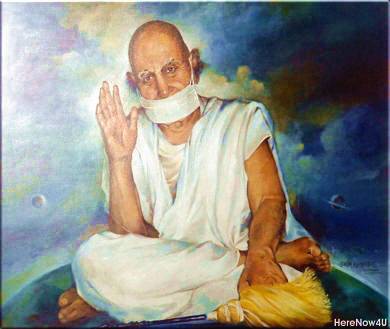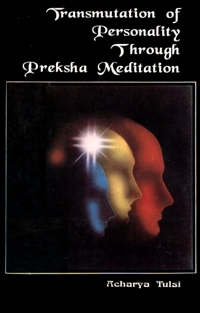
Relinquishing extraversion for introversion
Adds something new to the Book of Life.
It's no concentration, if the mind be perturbed.
Everlasting confusion; never a moment
of peace!
Man desires peace. The motive behind each and every activity of his is the attainment of tranquillity. The cosmic mind longs for harmony. Yet there is a great divergence between the nature of peace and the means adopted for achieving it. Actually, what is peace? And on what level can a man find it?
Man lives in two kinds of worlds: the outer world and the inner world.
The natural flow of human consciousness is outwards.
This consciousness expresses itself through two mediums: the sense organs and the mind.
The sense organs perceive the outer world.
The eye sees the external surfaces, the ear hears the exterior noises; the nose smells the scents outside; the tongue relishes the external flavours; and the skin experiences the feel of outside things.Likewise the mind is conditioned by outer impressions.
Thus, man is much more acquainted with the external environment. And even this knowledge of the outside world cannot be said to be complete. Man's contact with the outer world is limited, but with the inner world, he is not acquainted at all. How can a living being existing only at the level of the senses; and the mind come to know of it?
The first step for being acquainted with the inner world is the introversive consciousness. As long as a man continues with the old, a new beginning cannot be made. Without the opening of a new chapter, no acquaintance with the inner world is possible. And without this acquaintance, there can be no understanding of the nature of peace, nor its attainment. In order to attain peace, it is absolutely essential for consciousness to turn inwards. Only he who lives at the level of introversion can achieve tranquillity.
Since the natural flow of consciousness is outwards, what is the process of turning it inwards? No material thing can give up its intrinsic nature. How then can we expect the flow of consciousness to take a different turn?
The moment the sense organs lose contact with the outside world, the mind, freed from the web of uncertainties, becomes concentrated. The rays of consciousness then begin to penetrate inside. Inaction outside gives birth to inward action. The awakening of consciousness inside is introversion. A question may here arise as to how consciousness turns inside from outside. Not an unnatural question. But the fact is that consciousness never so turns; it is always inside. Only in the state of introversion, its flow changes. A change in direction takes place. The rays of consciousness which, before introversion, spread outwards, now radiate within. When the rays of consciousness flowing outward earlier begin to shine within, introversion takes place. In short, to be fully established in oneself is introversion. Although consciousness generally flows outwards, this is true only of heavily-veiled consciousness. As the veils are taken off, there is a change in the direction of the flow. At that time, extraversion is no longer natural, rather unnatural; it is then replaced by introversion. In view of this, it is very necessary for introversion to keep itself secure from the onslaught of outer environment.
In the Jain meditation-system introversion is called pratisamleenta, i.e. ‘embracing solitude (for God-realization).’ It has been defined in the lain-Sidhanta Deepika as follows:
To withdraw the senses from external objects - to turn their outgoing nature inwards, is pratisamleenta.
It is of four kinds:
- restraint of the senses
- restraint of the tendency to indulge in sorcery
- restraint of the passions
- secluded bedstead
Restraint means freedom from unprofitable pursuits and indulgence in profitable ones. Secluded bedstead means abiding in solitude. In the words of the great sage Patanjali, introversion has been called: renunciation. To isolate the senses - the eye, the ear, etc. from their objects, form, sound, etc., is renunciation. The more removed a man is from renunciation, solitude and introversion, the greater is his unrest. The practice of the three above - mentioned conditions - renunciation, aloneness and introversion is the royal highway to peace. An extrovert has no means of achieving mental peace, whereas there is no cause for disorder in an introvert's life. From this point of view, to turn inwards the outgoing flow of the rays of consciousness is to conquer unrest.
You have suggested that for achieving mental peace, one should advance along the royal highway of introversion. But the problem is, How to be introversive? How to embrace solitude? How to practise renunciation? What method do you recommend?
When a man is attached to material objects, his desires and options, certainties and uncertainties, increase. If he is not bound up with matter, there is no room for uncertainties to arise. When a man is tied to someone, he invites restlessness. The man who is not tied to anything, who is unattached, has no occasion to be grieved. What shall he pine for and why? Although man knows that the thing or person he is attached with, cannot save him, still he is not able to free himself from attachment. As long as attachment subsists in any form, there can be no peace.The man who desires peace, who wants to be alone, who wants to follow the path of renunciation, does not have to do anything except change his direction, i.e., his, approach, his way of looking at things. His complete identification with matter, he transfers to his inner being. A man who wanders in search of bliss outside, is caught in delusion. If there is happiness anywhere, it is inside oneself. To understand the current of joy, power and consciousness that flows within, to awaken and experience it, is the secret of introversion. The man who leams this secret, will never be unquiet.
Entry into oneself or turning away from external objects is the process, by which a sadhak becomes an inward gazer. What to speak of abiding peace, one does not get even momentary satisfaction without introversion. It is pleasant to hear the word, peace, but it is far more pleasant to attain it. But then one must know the technique of transforming unrest into tranquillity. The complete understanding of the process may not be possible at once, but the act of transferring or directing one's absorbing interest in material things into understanding ones inner being, the entity that one calls oneself, may be a way out of the problem.
 Acharya Tulsi
Acharya Tulsi
